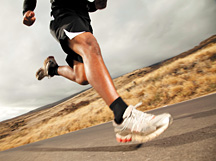Treating Shin Splints -- And Making Sure They Don't Come Back
By Robert Lucarelli, LMT
Whether you are a pro athlete, a weekend warrior or just on your feet all day, shin splints can strike at any time, causing substantial pain. Fortunately, there are precautionary measures you can take to prevent painful shin splints from occurring and/or get you back to full health if you're suffering from shin splints.
Here's an introduction to this common condition and information you should discuss with your doctor if you suspect you have shin splints.
What Are They?
Shin splints are muscle tears and hairline fractures in the anterior tibialis and tibia (shinbone). That's the bone on the front of your lower leg. Shin splints are common to runners, basketball players, tennis players or anyone who is on their feet all day, such as grocery clerks, security officers, nurses, construction workers, etc.
The pain from shin splints can be mild or severe. Location of the pain varies according to which part of the lower leg structure has been damaged. If the tibia is red, hot and swollen, suspect a more severe injury than muscle damage to the lower leg.
Potential Causes
 Strength discrepancies can cause damage to the anterior leg. The anterior tibialis may be too weak to absorb impact .The calf may generate too much force for the muscles of the front of the leg to absorb impact when landing on a hard surface. Sometimes, inadequate padding in shoes can also cause problems to the lower leg.
Strength discrepancies can cause damage to the anterior leg. The anterior tibialis may be too weak to absorb impact .The calf may generate too much force for the muscles of the front of the leg to absorb impact when landing on a hard surface. Sometimes, inadequate padding in shoes can also cause problems to the lower leg.
From a biomechanical perspective, there are three types of "levers" in the body: first-, second- and third-class levers. When walking, the foot moves [pivots] via a second-class lever. The force is generated from the calf, the axis of rotation or pivot point, is the ball of the foot and the resistance goes down the middle of the body. A mechanical example would be a wheel barrow. The force is generated from the handles, the wheel is the pivot point and the resistance is in the middle of the wheel barrow.
The point is, if the body is not lined up correctly due to the spinal vertebrae being misaligned or muscles pulling the body off its center of balance, it may cause stress all the way down to the foundation of the body, which in this case would be the lower legs.
Treatment/Prevention Tips
Chiropractic: Shin splints are often brought about by improper biomechanics of the foot and knee or misalignment of the ankle, hip or spine. A chiropractic evaluation can assess biomechanical discrepancies of the spine, pelvis and ankles that may be contributing to the condition. Misalignment of the body can produce undue stress on the anterior compartment of the lower leg, causing shin splints to occur; chiropractic adjustments can help alleviate or prevent the condition.
Strength Training: Shin splints may be caused by the gastrocnemius [the calf] overpowering the tibialis anterior. When the calf muscles are tight, the anterior muscles [front muscles] of the leg are usually weak. Tight calves can cause anterior or frontal muscles to be overstretched. Overstretched muscles become weakened and inflamed. This is common in people who wear high-heeled shoes and/or don't work out the front of their leg. Here are a few exercises to help prevent shin splints.

